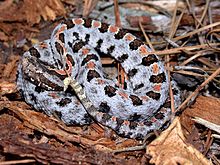Sistrurus
| Sistrurus | |
|---|---|
 |
|
| Pigmy rattlesnake, S. miliarius. | |
| Scientific classification | |
| Kingdom: | Animalia |
| Phylum: | Chordata |
| Subphylum: | Vertebrata |
| Class: | Reptilia |
| Order: | Squamata |
| Suborder: | Serpentes |
| Family: | Viperidae |
| Subfamily: | Crotalinae |
| Genus: |
Sistrurus Garman, 1884 |
 |
|
| Synonyms | |
Sistrurus is a genus of venomous pit vipers found in Canada, the United States and Mexico. The name is a Latinized form of the Greek word for "tail rattler" (Σείστρουρος, Seistrouros) and shares its root with the ancient Egyptian musical instrument, the sistrum, a type of rattle. Three species are currently recognized.
Sistrurus species differ from the larger rattlesnakes of the genus Crotalus in a number of ways. They are smaller in size, but also their scalation is different: Sistrurus species have nine large head plates (same as Agkistrodon), whereas with Crotalus (and almost all other viperids) the head is mostly covered with a large number of smaller scales. Sistrurus species have a relatively small rattle that produces more of a high-pitched, buzzing sound than a rattle, like Crotalus.
Found in southeastern Canada, the eastern and southeastern United States, as well as isolated populations in northern and central Mexico.
Although bites from Sistrurus species are regarded as less dangerous to humans than those from Crotalus rattlesnakes, primarily due to their lower venom yield, every venomous snake bite should be considered serious and prompt medical treatment should always be sought.
† Type species.
...
Wikipedia
